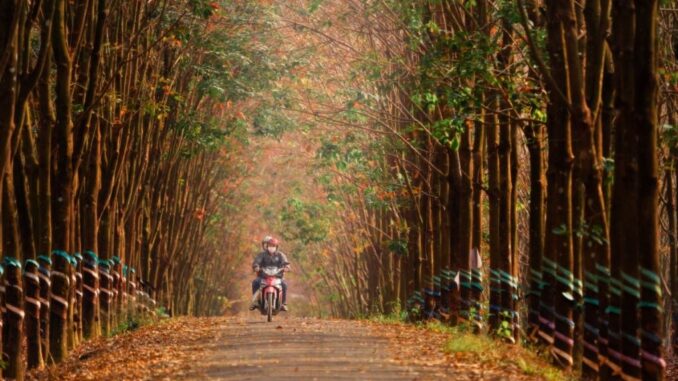
BA RIA – VUNG TAU – These days, Cu Be rubber forest wears a red and yellow leaf shirt, in harmony with the peaceful rhythm of life as if holding tourists back.

At the beginning of January, 8X photographer Cao Ky Nhan (from Phu Yen, now living in Ho Chi Minh City) transferred his photography experience to a rubber forest in Cu Be commune, Chau Duc district, Ba Ria – Vung Tau province. This forest belongs to Cu Be rubber farm, has an area of over 3,800 hectares of rubber, and borders Dong Nai province to the north and west.

Every year, from the end of December to March of the following year, the Southeast region in general, and Cu Be in particular, enter the rubber season to change leaves. Tourists traveling on Highway 51, Long Thanh district, Dong Nai province turn onto a small road and run towards Cu Be commune. The rubber here is thick and large, at the time of season change, the leaves turn yellow, red and dreamy.
According to Mr. Nhan, people come here to take pictures freely, if they meet workers taking rubber latex, they should ask their permission to take pictures.

The inter-village traffic routes through the Cu Be rubber forest is red dirt roads, formerly often muddy in the rainy season and dusty on a sunny day, today are local investments in infrastructure, clean asphalt.

Although not as famous as the rubber forests in Binh Phuoc, Binh Duong and Dong Nai, Cu Be still attracts tourists, photographers to compose or couples to take wedding photos.
Ms. Bui Thi Tuyet Loan (left) and Cao Thi Ngoc Diem, both from Ho Chi Minh City, coming to this rubber forest for the first time, shared that they were impressed by the natural picture full of green, red, and yellow colors, standing Any angle when “adventure”, check-in can also create a beautiful photo.

Another perspective when shooting Cu Be rubber forest. Nhan said that this place is far from residential areas, so when taking photos, everyone should bring food and water, pay attention to preserve the general landscape and do not litter.

When taking photos, pay attention to the weather on a sunny day, the best light is in the early morning (if you’re lucky, you will meet the fog covering the whole forest) when the sun is up and around 15-16h in the afternoon. before sunset.

A moment of peaceful Cu Be. The rubber tree is native to the Amazon forest, South America. In the Mainas dialect, “ouchouk” is the name for the rubber tree, which also means tears of the tree. Following in the footsteps of the French, rubber trees came to Vietnam at the end of the 19th century and quickly became the main industrial tree.

Rubber trees planted about 5-6 years old will give latex, a raw material for the production of many useful items such as tires, rubber bands, mattresses or medical equipment. The rubber latex extraction season takes place from about May to February next year.
Workers exploit rubber latex at dawn, from 3 to 7 am. The work is quite hard work, but for many workers, this is their main source of income.

The asphalt road crossing the Cu Be rubber forest is quite deserted, sometimes there are motorbikes and cars passing by. The season of rubber leaves changing leaves is normal in the eyes of locals, but for many tourists, it is very poetic. Towards the end of the season, the last rubber leaves fall, leaving the whole forest with only thin branches.
Visitors should take pictures and return during the day, limit contact with strangers or stay overnight. Follow (vnexpress)
Photo: Cao Ky Nhan
